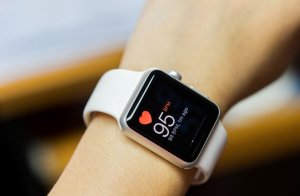Tips to Take Into Account to Measure Heart Rate

When we talk about a heart, we value its ability to provide life. Whether you participate in a physical activity or not, the heart rate, or the number of times your heart contracts and relaxes in one minute can tell you how much anaerobic power the body is demanding.
How do you know what your heart rate is?
The heart has one main function: to pump blood. And each time it does, it must contract and generate an impulse that can carry the blood to your entire body. In turn, it carries the oxygen necessary to perform the functions of everyday activities and the physical demands of a sport.

But, because of the number of extremities that your body has, the heart’s job is not as simple as we might think.
The pulse in your heart must be strong enough to maintain a certain pressure, with a stable frequency, and at a certain time. This is known as your heart rate, and this rate uses a huge energy expenditure.
Why measure your heart rate?
Your heart’s function is frequent and important, so you must know how to measure your rate. You can measure your heart rate based on the physical activity that you are doing. This will allow you to optimize your physical effort and to not reach a point where your health is impaired by excessive effort.
Therefore, to calculate or measure your heart rate, you must take your pulse. You can do this by using an electronic device or simply, with your fingers.
How to measure your heart rate
If you measure it by placing your fingers on your wrist, you must use your index and middle finger and you must place them where you know an artery passes. Usually, this is done in the neck where the carotid artery is, or in the wrist where the radial artery is. Both arteries pass very close to the skin and it’s easy to feel the pulsation.
Once you identify the pulse point, press lightly with your fingers and count how many beats you have, within the time frame of one minute.
If you measure your heart rate with a device, it must be adjusted to your body where it’s comfortable to wear. There are some devices that are worn on the wrist, as if it were a watch, and there are also some with an elastic band that is placed on the chest and the readings are digital. These come with other added functions too.

Tips to measure your heart rate
You don’t have to be a professional athlete to pay attention to your heart rate. It is generally important to know what your maximum heart rate is. Both in physical activity and in your daily life, and it is useful to know what rate your heart can reach so that you do not risk your health.
The steps you need to follow to measure your heart rate:
- Take into account that there are several types of heart rate. The first thing is to know your resting heart rate. This would be your starting point. Sit and relax for five to eight minutes. Otherwise, a movement will accelerate your pulse and it will not be a correct reading.
- Identify the part of your body where you will try to measure your pulse. Usually your neck and wrists are the most accessible areas.
- Now, you will press lightly with your index and middle finger at the point where you can feel your pulse.
- Start counting the number of pulses (or beats) within one minute. You could also count for 10 seconds and multiply the answer by six, to give you the beats per minute (bpm).
- This method is practical and simple and can help you to measure your effort if you are exercising.
Know your heart rate

Health and sports professionals establish a heart rate to serve as a reference, according to the activity that you are doing.
For example, in women under 60 years of age, the frequency rate ranges from, 78 to 102 bpm. And in women over 60 years of age, the frequency rate will range from, 88 to 106 bpm. While in men under 60 years of age, the frequency will be 70 – 88 bpm, and if men are over 60 years of age, it will be in the region of 76 to 90 bpm.
The normal heart rate of a person at rest, and over 20 years of age, should be between 50 and 100 bpm. If your frequency is lower or higher than this, it’s advisable that you visit a specialist, since there are other factors that can alter it.
Therefore, checking your heart rate should be a part of your routine. This way, if we notice a significant change in our rate, when we carry out an activity, we know that the activity can be a risk factor to our health. But of course, you have to take into account your age and physical condition.
When we talk about a heart, we value its ability to provide life. Whether you participate in a physical activity or not, the heart rate, or the number of times your heart contracts and relaxes in one minute can tell you how much anaerobic power the body is demanding.
How do you know what your heart rate is?
The heart has one main function: to pump blood. And each time it does, it must contract and generate an impulse that can carry the blood to your entire body. In turn, it carries the oxygen necessary to perform the functions of everyday activities and the physical demands of a sport.

But, because of the number of extremities that your body has, the heart’s job is not as simple as we might think.
The pulse in your heart must be strong enough to maintain a certain pressure, with a stable frequency, and at a certain time. This is known as your heart rate, and this rate uses a huge energy expenditure.
Why measure your heart rate?
Your heart’s function is frequent and important, so you must know how to measure your rate. You can measure your heart rate based on the physical activity that you are doing. This will allow you to optimize your physical effort and to not reach a point where your health is impaired by excessive effort.
Therefore, to calculate or measure your heart rate, you must take your pulse. You can do this by using an electronic device or simply, with your fingers.
How to measure your heart rate
If you measure it by placing your fingers on your wrist, you must use your index and middle finger and you must place them where you know an artery passes. Usually, this is done in the neck where the carotid artery is, or in the wrist where the radial artery is. Both arteries pass very close to the skin and it’s easy to feel the pulsation.
Once you identify the pulse point, press lightly with your fingers and count how many beats you have, within the time frame of one minute.
If you measure your heart rate with a device, it must be adjusted to your body where it’s comfortable to wear. There are some devices that are worn on the wrist, as if it were a watch, and there are also some with an elastic band that is placed on the chest and the readings are digital. These come with other added functions too.

Tips to measure your heart rate
You don’t have to be a professional athlete to pay attention to your heart rate. It is generally important to know what your maximum heart rate is. Both in physical activity and in your daily life, and it is useful to know what rate your heart can reach so that you do not risk your health.
The steps you need to follow to measure your heart rate:
- Take into account that there are several types of heart rate. The first thing is to know your resting heart rate. This would be your starting point. Sit and relax for five to eight minutes. Otherwise, a movement will accelerate your pulse and it will not be a correct reading.
- Identify the part of your body where you will try to measure your pulse. Usually your neck and wrists are the most accessible areas.
- Now, you will press lightly with your index and middle finger at the point where you can feel your pulse.
- Start counting the number of pulses (or beats) within one minute. You could also count for 10 seconds and multiply the answer by six, to give you the beats per minute (bpm).
- This method is practical and simple and can help you to measure your effort if you are exercising.
Know your heart rate

Health and sports professionals establish a heart rate to serve as a reference, according to the activity that you are doing.
For example, in women under 60 years of age, the frequency rate ranges from, 78 to 102 bpm. And in women over 60 years of age, the frequency rate will range from, 88 to 106 bpm. While in men under 60 years of age, the frequency will be 70 – 88 bpm, and if men are over 60 years of age, it will be in the region of 76 to 90 bpm.
The normal heart rate of a person at rest, and over 20 years of age, should be between 50 and 100 bpm. If your frequency is lower or higher than this, it’s advisable that you visit a specialist, since there are other factors that can alter it.
Therefore, checking your heart rate should be a part of your routine. This way, if we notice a significant change in our rate, when we carry out an activity, we know that the activity can be a risk factor to our health. But of course, you have to take into account your age and physical condition.
All cited sources were thoroughly reviewed by our team to ensure their quality, reliability, currency, and validity. The bibliography of this article was considered reliable and of academic or scientific accuracy.
- Avram R, Tison GH, Aschbacher K, Kuhar P, Vittinghoff E, Butzner M, Runge R, Wu N, Pletcher MJ, Marcus GM, Olgin J. Real-world heart rate norms in the Health eHeart study. NPJ Digit Med. 2019 Jun 25;2:58.
- Pickering D. How to measure the pulse. Community Eye Health. 2013;26(82):37.
- Vogel CU, Wolpert C, Wehling M. How to measure heart rate? Eur J Clin Pharmacol. 2004 Sep;60(7):461-6.
This text is provided for informational purposes only and does not replace consultation with a professional. If in doubt, consult your specialist.








